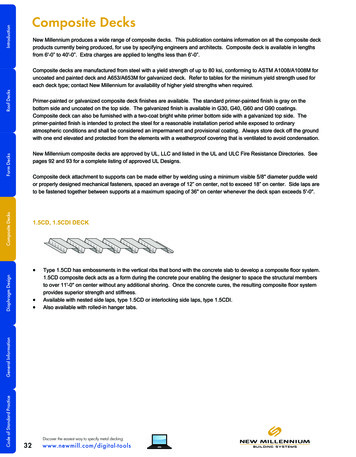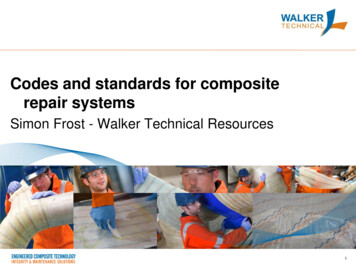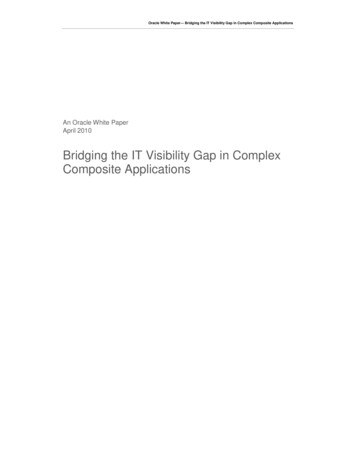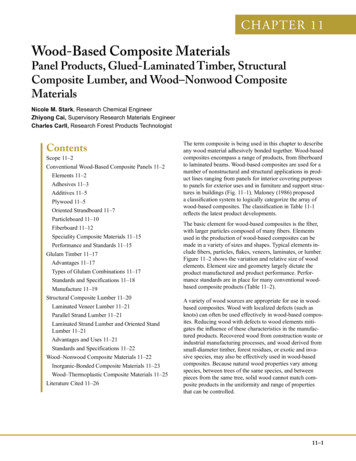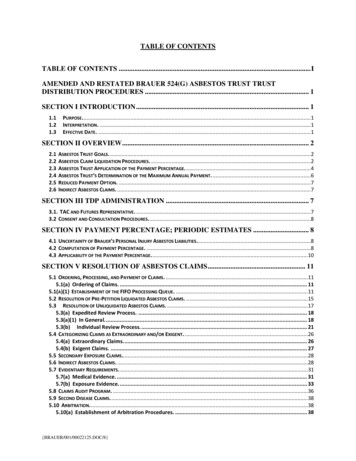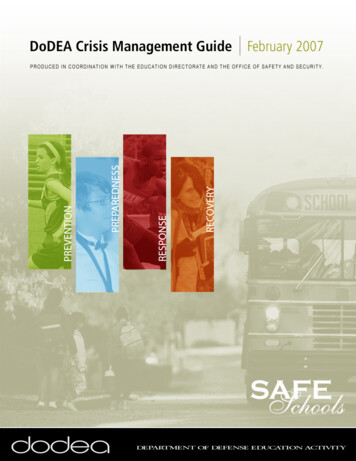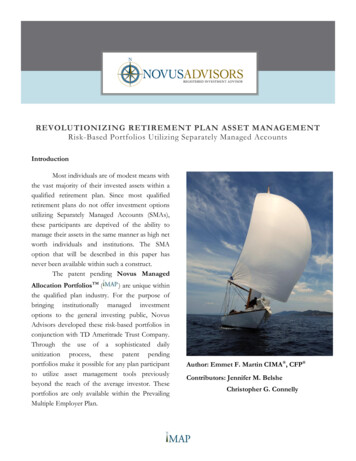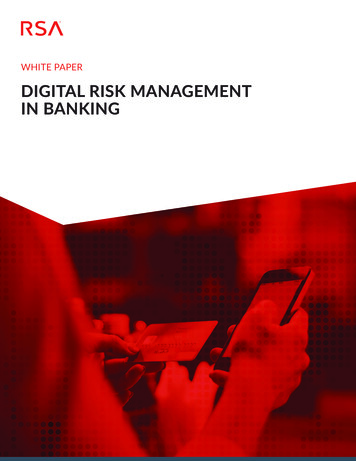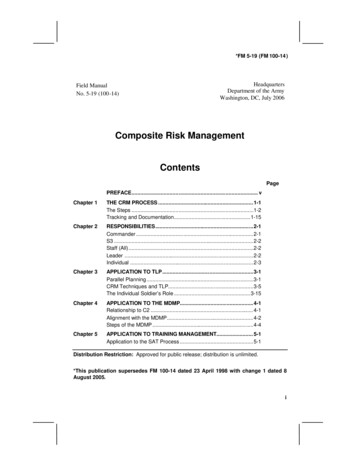
Transcription
*FM 5-19 (FM 100-14 )HeadquartersDepartment of the ArmyWashington, DC, July 2006Field ManualNo. 5-19 (100-14)Composite Risk ManagementContentsPagePREFACE. vChapter 1THE CRM PROCESS .1-1The Steps .1-2Tracking and Documentation.1-15Chapter 2RESPONSIBILITIES.2-1Commander .2-1S3 .2-2Staff (All).2-2Leader .2-2Individual .2-3Chapter 3APPLICATION TO TLP.3-1Parallel Planning .3-1CRM Techniques and TLP.3-5The Individual Soldier’s Role .3-15Chapter 4APPLICATION TO THE MDMP.4-1Relationship to C2 .4-1Alignment with the MDMP. 4-2Steps of the MDMP .4-4Chapter 5APPLICATION TO TRAINING MANAGEMENT. 5-1Application to the SAT Process .5-1Distribution Restriction: Approved for public release; distribution is unlimited.*This publication supersedes FM 100-14 dated 23 April 1998 with change 1 dated 8August 2005.i
ContentsIntegration into Realistic Training . 5-2Chapter 6APPLICATION TO OTHER FUNCTIONAL AREAS .6-1Command Issues.6-1Command Emphasis . 6-2Appendix A INSTRUCTIONS AND SAMPLE FORM.A-1Appendix B EXAMPLES FOR OPERATIONS. B-1GLOSSARY.Glossary-1SECTION I – ACRONYMS AND ABBREVIATIONS .Glossary-1SECTION II – TERMS . Glossary-6REFERENCES .References-1INDEX.Index-1FiguresFigure 1-1. CRM .1-1Figure 1-2. CRM process .1-3Figure 1-3. Assessment factors .1-4Figure 1-4. Risk assessment matrix.1-8Figure 3-1. TLP and risk management steps .3-2Figure 3-2. MDMP and TLP .3-3Figure 3-3. Information flow .3-4Figure 3-4. Sample hasty risk assessment .3-6Figure 3-5. Platoon WARNO. 3-7Figure 3-6. Risk assessment factors. 3-9Figure 3-7. Sample verbal order.3-12Figure 3-8. Sample graphic overlay .3-13Figure 3-9. Sample terrain sketch .3-14Figure 4-1. CRM aligned with C2 .4-2Figure 4-2. CRM aligned with the MDMP.4-3Figure 4-3. Input and output for the MDMP .4-4Figure 4-4. Sample WARNO. 4-6Figure 4-5. Sample overlay .4-7Figure 4-6. Sample staff estimate . 4-8Figure 4-7. Sample risk assessment.4-10iiFM 5-19July 2006
ContentsFigure 4-8. Risk management application to step 2 of theMDMP . 4-11Figure 4-9. Sample risk assessment for G1/AG/S1 . 4-12Figure 4-10. Sample risk assessment for G2/S2. 4-12Figure 4-11. Sample risk assessment for G3/S3. 4-13Figure 4-12. Sample risk assessment for G4/S4. 4-13Figure 4-13. Sample risk assessment for G5/S5. 4-14Figure 4-14. Sample risk assessment for G6/S6. 4-14Figure 4-15. Sample risk assessment for air and missiledefense coordination. 4-15Figure 4-16. Sample risk assessment for fire supportcoordination. 4-15Figure 4-17. Sample risk assessment for engineercoordination. 4-16Figure 4-18. Sample risk assessment for NBC coordination. 4-16Figure 4-19. Sample risk assessment for medicalcoordination. 4-17Figure 4-20. Sample execution paragraph . 4-18Figure 4-21. Risk assessment matrix . 4-20Figure 5-1. Comparison . 5-2Figure A-1. Sample DA Form 7566, page 1 .A-2Figure A-2. Sample DA Form 7566, page 2 .A-3Figure B-1. Sample worksheet for tactical road marchscenario. B-3Figure B-1. Continued. B-4Figure B-2. Sample worksheet for aviation scenario .B-6Figure B-2. Continued. B-7Figure B-3. Sample worksheet for field artillery scenario . B-10Figure B-3. Continued. B-10Figure B-4. Sample worksheet for base operations scenario . B-12Figure B-5. Sample worksheet for POV/party scenario . B-13Figure B-6. Sample worksheet for weekend pass scenario . B-14July 2006FM 5-19iii
ContentsTablesTable A-1. Worksheet Instructions. A-1ivFM 5-19July 2006
PrefaceToday’s Army is challenged by a wide range of threats and operating environments. Thesechallenges, plus new technologies, require our leaders to use creative measures to providepositive protection to our Soldiers and equipment.In April 1998, Field Manual (FM) 100-14 introduced to the Army the first doctrinalpublication on risk management. It detailed the application of a step-by-step process toconserve combat power and resources. This milestone manual outlined a framework thatleaders could use to make force protection a routine part of planning, preparing, andexecuting operational, training, and garrison missions.Before the outset of the global war on terrorism it became apparent that FM 100-14 wouldrequire updating to meet the needs of the future. Army assessments also indicated that theexisting manual needed to be expanded to provide clear standards and guidance on how therisk management process was to be applied. This led to this current revision. Duringdevelopment of this revision the Army broadened its understanding of the risk managementprocess to encompass all operations and activities, on and off duty. This holistic approachfocuses on the composite risks from all sources rather than the traditional practice ofseparating accident from tactical hazards and associated risks. This revision has beenrefocused to clearly reflect the Army’s new composite approach, and has been retitledComposite Risk Management (CRM). CRM represents a culture change for the Army. Itdeparts from the past cookie cutter safety and risk management mentality through teachingSoldiers “how to think” rather than telling them “what to think.”This manual expands the context of the original FM by focusing on the application ofcomposite risk management to the military decisionmaking process (MDMP) and the Armytraining management system. It further assigns the responsibilities for conducting riskmanagement training during initial entry training and professional military education. It is atool that works in conjunction with the Army’s on-going initiative to firmly attach CRM toall Army processes.It is a milestone document for the standardization and institutionalization of the techniques,tools, and procedures that lead to sound decisionmaking and valid risk acceptance byleaders at all levels. This revision is a full rewrite of FM 100-14. It marks a break with thepast by integrating the CRM process into Army operations. CRM is not a stand-aloneprocess, a “paper work” drill, or an add-on feature. Rather, it is used as a fully-integratedelement of detailed planning. It must be so integrated as to allow it to be executedintuitively in situations that require immediate action. CRM should be viewed as part of themilitary art interwoven throughout the Army’s military decisionmaking and trainingmanagement cycles.July 2006FM 5-19v
PrefaceThis manual applies to the Active Army, the Army National Guard/Army National Guard ofthe United States, and the United States Army Reserve unless otherwise stated.The proponent of this manual is Headquarters (HQ), U.S. Army Training and DoctrineCommand. Send comments and recommendations on Department of the Army (DA) Form2028 directly to Commander, U.S. Army Training and Doctrine Command, ATTN: ATCSS, Fort Monroe, Virginia 23651-5000.viFM 5-19July 2006
Chapter 1The CRM ProcessComposite risk management (CRM) is the Army’s primarydecisionmaking process for identifying hazards and controllingrisks across the full spectrum of Army missions, functions,operations, and activities. (See Figure 1-1.)Figure 1-1. CRMCRM is a decisionmaking process used to mitigate risksassociated with all hazards that have the potential to injure or killpersonnel, damage or destroy equipment, or otherwise impactmission effectiveness. In the past, the Army separated risk intotwo categories, tactical risk and accident risk. While these twoareas of concern remain, the primary premise of CRM is that itJuly 2006FM 5-191-1
Chapter 1does not matter where or how the loss occurs, the result is thesame—decreased combat power or mission effectiveness. Theguiding principles of CRM are as follows: Integrate CRM into all phases of missions and operations.Effective CRM requires that the process be integrated intoall phases of mission or operational planning, preparation,execution, and recovery. Make risk decisions at the appropriate level. As adecisionmaking tool, CRM is only effective when theinformation is passed to the appropriate level of commandfor decision. Commanders are required to establish andpublish approval authority for decisionmaking. This maybe a separate policy, specifically addressed in regulatoryguidance, or addressed in the commander’s trainingguidance. Approval authority for risk decisionmaking isusually based on guidance from higher HQ. Accept no unnecessary risk. Accept no level of riskunless the potential gain or benefit outweighs the potentialloss. CRM is a decisionmaking tool to assist thecommander, leader, or individual in identifying, assessing,and controlling risks in order to make informed decisionsthat balance risk costs (losses) against mission benefits(potential gains). Apply the process cyclically and continuously. CRM is acontinuous process applied across the full spectrum ofArmy training and operations, individual and collectiveday-to-day activities and events, and base operationsfunctions.It is a cyclic process that is used tocontinuously identify and assess hazards, develop andimplement controls, and evaluate outcomes. Do not be risk averse. Identify and control the hazards;complete the mission.THE STEPS1-1. CRM is a five-step process: Step 1 – Identify hazards.1-2FM 5-19July 2006
The CRM Process Step 2 – Assess hazards to determine risk.Step 3 – Develop controls and make risk decisions. Step 4 – Implement controls. Step 5 – Supervise and evaluate.Steps 1 and 2 are assessment steps, steps 3 through 5 are management. See Figure 1-2. Figure 1-2. CRM processSTEP 1- IDENTIFY H AZARDS1-2. What is a hazard? A hazard is a condition with the potential to cause injury, illness, ordeath of personnel; damage to or loss of equipment or property; or mission degradation. Ahazard may also be a situation or event that can result in degradation of capabilities ormission failure. Hazards exist in all environments—combat operations, stability operations,base support operations, training, garrison activities, and off-duty activities.1-3. How are hazards identified? The factors of mission, enemy, terrain and weather,troops and support available, time available, and civil considerations (METT-TC) serve asa standard format for identification of hazards, on-duty or off-duty. The factors of METTTC are used because they are institutionalized in the Army. They are part of the commonknowledge imparted through the Army’s professional military education and initial entrytraining. See Figure 1-3.July 2006FM 5-191-3
Chapter 1Figure 1-3. Assessment factors1-4. Some other resources and tools to assist in the identification of hazards are as follows: Experience and other experts. Regulations, manuals, standing operating procedures (SOPs), policies. Accident data. War-gaming what-if scenarios. Risk assessment matrices. Readiness assessments. Cause and effect diagrams. Change analysis. Energy trace and barrier analysis. Logic diagrams. Mapping techniques. Training assessments. After-action reviews (AARs).Sources of Hazards and Risks1-5. Hazards may arise from any number of areas. Hazards can be associated with enemyactivity, accident potential, weather or environmental conditions, health, sanitation,behavior, and/or material or equipment. CRM does not differentiate between the sources ofthe hazard. The loss of personnel, equipment, or material due to any hazard has the same1-4FM 5-19July 2006
The CRM Processdisruptive impact on readiness or mission capabilities no matter what the source. Anindividual may have a greater influence to effect change in hazards arising from behavior,accident potential, equipment, or material than over hazards that arise from enemy action.The bottom-line is the effect of the hazard, not its source.The Role of METT-TC in Hazard Identification1-6. The factors of METT-TC provide a standardized methodology for addressing boththreat and hazard-based risk for tactical and nontactical operations and off-duty activities.METT-TC is primarily used as part of the MDMP for tactical missions. However, the samethought process is equally effective for considering nontactical operations and the off-dutyenvironment. When applied in a tactical or operational environment, the factors of METTTC require no explanation. The same factors can be applied in nonmilitary activities. Forthe sake of clarity, however, the terms are changed to reflect the nonmilitary application asdepicted in Figure 1-3.1-7. For garrison and off-duty activities the METT-TC factors become activities, disrupters,terrain and weather, personnel, time, and legal considerations. Both processes addresssimilar considerations expressed in different terms.Mission1-8. The nature of the operational mission may imply specific hazards. Some missions areinherently more dangerous than others. Leaders look for hazards associated with thecomplexity of higher HQ plans and orders such as a particularly complex scheme ofmaneuver. The use of a fragmentary order (FRAGO) in-lieu of a detailed operation order(OPORD) or operation plan (OPLAN) also may raise the risk due to the possibility ofmisunderstanding.Activity1-9. This pertains to garrison on- and off-duty activities. The classic example is a riskassessment performed in preparation of a long holiday weekend. It could also be performedfor a recreational or sporting event or for travel associated with leave, pass, or temporaryduty (TDY). Junior leaders play a particularly important role in making assessments thataddress the behavior traits of individual Soldiers. Events where there is alcohol present orthe potential for substance abuse require special focus.Enemy1-10.Commanders look for enemy presence or capabilities that pose hazards to theoperation or mission. What can the enemy do to defeat my operation? Intelligencepreparation of the battlefield (IPB) is a dynamic staff process that is critical to identifyingenemy threat. IPB supports threat based risk assessments by identifying opportunities andany constraints the battlefield environment offers to both enemy and friendly forces. It alsoportrays a picture of enemy capabilities and vulnerabilities.July 2006FM 5-191-5
Chapter 1Disrupters1-11.In the on- and off-duty garrison environment enemy considerations take the formof outside influences that may affect or impact a planned event or activity.Terrain and Weather1-12.The factors of observation and fields of fire, avenues of approach, key anddecisive terrain, obstacles, and cover and concealment (OAKOC) are used to identify andassess hazards impacting on mission type operations. Pretrip checklists are useful in makingassessments associated with nonmission activities. Common terrain hazards are elevation,altitude, road surfaces, curves, grades, and traffic density.1-13.Common weather hazards are cold, ice, snow, rain, fog, heat, humidity, wind,dust, visibility and illumination. Whether planning a tactical mission or out-of-town leave,include the aspect of terrain. Weather can also create very specific hazards. Leaders assessthese factors for both mission and nonmission activities.Troops (or People) and Equipment1-14.For mission-related risk assessments, the term troops is used to consider hazardsthat are associated with the level of training, staffing, and equipment maintenance andcondition. It also includes morale, availability of supplies, and services to include thephysical and emotional health of the Soldiers.1-15.For nonmission activities, the term people is used to include Soldiers, theirdependents, civilian workers, and other people whether connected to the activity or not.Some examples of other-than-mission hazards may include such things as sexual assault,domestic violence, substance abuse, sexually transmitted diseases, and other behavioral ormedical conditions.Time1-16.Insufficient time for mission preparation often forces commanders to acceptgreater risk in planning, preparation, and execution of orders and plans associated withmission planning. To avoid or mitigate the risk associated with inadequate time forplanning, leaders should allow subordinates two-thirds of the available planning time as acontrol. For nonmission activities insufficient time is more of a matter of haste as opposedto availability. This is especially critical during holiday periods where the zeal of youngSoldiers to get home may lead them to depart duty stations without sufficient rest.Civil or Legal Considerations1-17.This function expands the consideration of hazards to include those hazards thata
Composite risk management (CRM) is the Army’s primary decisionmaking process for identifying hazards and controlling risks across the full spectrum of Army missions, functions, operations, and activities. (See Figure 1-1.) Figure 1-1. CRM CRM is a decisionmaking process used to mitigate risks
